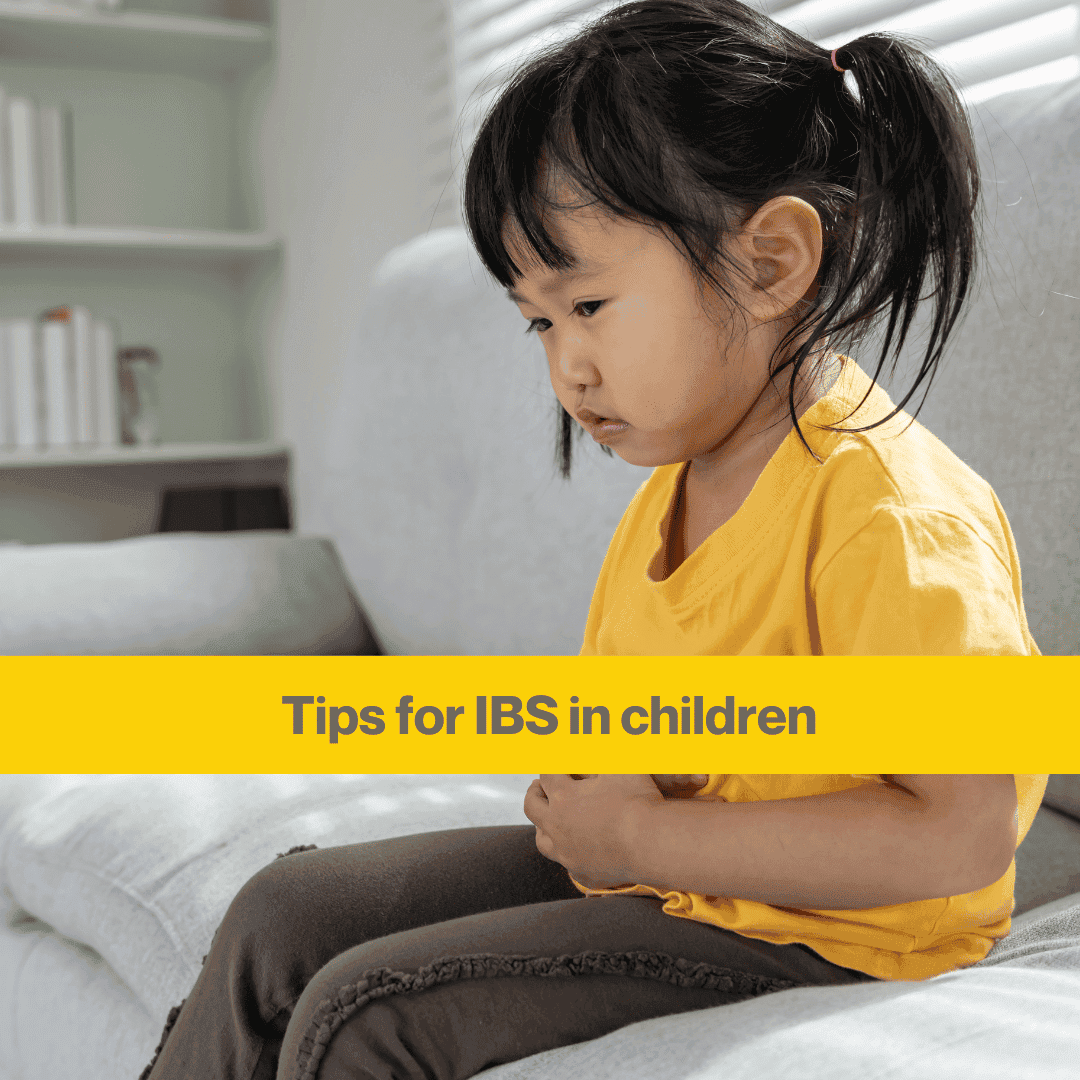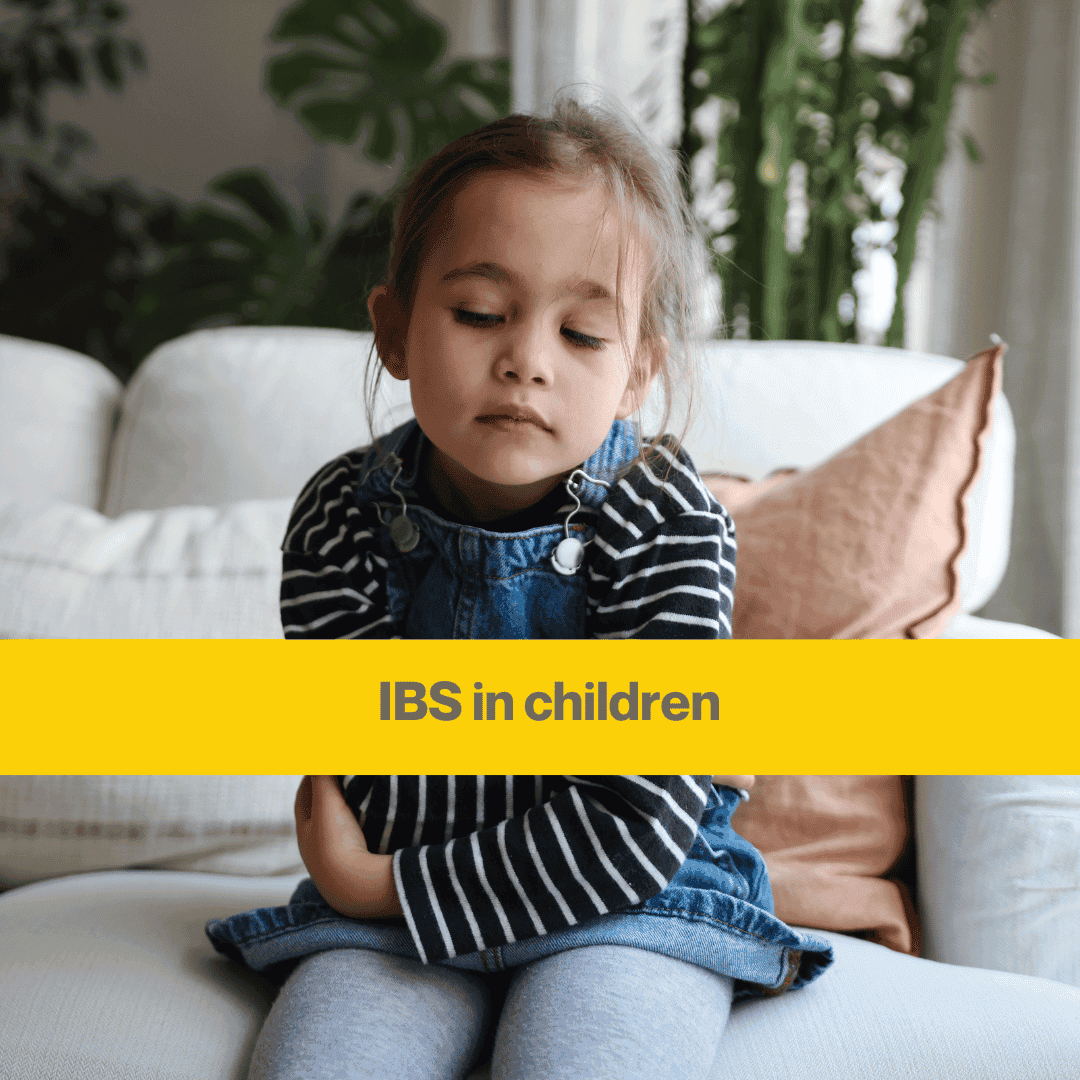Part 1 – IBS in Children
IBS in children can be difficult to manage because you’re often trying to interpret symptoms on their behalf. Unlike adults, children may not always have the language to describe how they feel, which makes spotting patterns and getting a diagnosis more challenging. I don’t often work with children (mostly because my hours don’t align with school hours!).
In this post, I’ll cover:
What IBS in children looks like
Risk factors that may contribute to IBS
How gut health develops in babies and children
Practical steps you can take to support your child’s digestion

What is IBS in children?
Irritable bowel syndrome (IBS) is diagnosed in children in much the same way as in adults. Doctors look for a pattern of abdominal pain linked with changes in bowel movements that has lasted for at least three months.
Typical IBS symptoms in children include:
Frequent tummy aches (especially after eating or later in the day)
Constipation, diarrhoea, or alternating between the two
Excess wind, burping or bloating (a noticeably distended stomach)
Accidents or soiling, particularly if stools are loose or painful to pass
Skid marks in underwear due to sore bottoms or difficulty wiping
Changes in appetite, such as picking at food or avoiding meals
Because children sometimes use the phrase “my tummy hurts” to express emotions like anxiety or anger, it can be hard to know whether the pain is physical or emotional.
Keeping a symptom and food diary
This is where careful observation and record keeping can help. Keep a diary of when they are feeling worse so you can look for patterns.
Risk factors for IBS in children
The causes of IBS aren’t fully understood, but several factors can increase the risk:
Gut–brain connection: Stress, anxiety or worry can trigger IBS symptoms in children, just as in adults. Younger children may not have the words to express emotions and instead describe them as “tummy aches”.
Food sensitivities: Undiagnosed coeliac disease, food allergies or lactose intolerance can cause IBS-type symptoms.
Early gut health development: The first three years of life are key for shaping a child’s gut microbiome. Factors such as birth method (vaginal vs C-section), breastfeeding vs formula feeding, exposure to siblings or pets, and early diet all play a role.
Structural or medical issues: Rarely, conditions like strictures, inflammatory bowel disease, or undiagnosed food allergies can mimic IBS symptoms.
Because other conditions can look like IBS, it’s important to seek medical advice before assuming it is IBS. It seems the age where IBS is most common in children is around 8-12 years old.
Gut health in children
The first thousand days of a baby’s life help to inform the gut microbiome. The collection of microbes influence how we digest food, as well as interact with our immune system, skin and hormones.
The microbes are passed from mother to baby during birth. After a C-section birth a baby’s gut and skin microbes normally have different colonies of bacteria. This doesn’t necessarily mean you need to give your C-section baby probiotics but you could focus on a healthy diet when weaning and your child is growing.
Positive influences on a child’s gut include time spent outside, eating fibre (vegetables and fruit, wholegrains, pulses and seeds), active play and daily movement, and healthy sleep.

Supporting your child with IBS
If you think your child may have IBS, here are some practical steps that can help:
1. Track symptoms
Keep a record of bowel movements, tummy aches, food intake and any patterns you notice. This helps you and your doctor spot connections and gives a clearer picture than memory alone.
2. Focus on the basics
Before making dietary changes, check simple factors such as:
Hydration: Encourage your child to drink water regularly, especially before and after school.
Fibre: Aim for a mix of fibres (bulk-forming and gel-forming) through fruits, vegetables and whole foods. A “rainbow challenge” (eating different colours each day) can make this fun for children.
Balanced meals: Ensure they’re eating regular meals with some safe, familiar foods as well as a variety of options.
3. Involve them in food
Making food preparation fun can reduce fussiness and build confidence with new foods. Let them help choose vegetables, stir ingredients, or plate up their meals.
4. Be cautious with restrictive diets
While the low FODMAP diet is well researched in adults, there is limited evidence for children. If you suspect food triggers, speak to a paediatric dietitian before removing major food groups like dairy or gluten.
Removing gluten unnecessarily can reduce the fibre content of a child’s diet, which can lead to further gut issues.
5. Communicate openly
Normalise talking about poo, wind and tummy aches at home so children don’t feel embarrassed. It may also help to inform teachers or nursery staff if your child needs quick toilet access or extra understanding.
Download free IBS workbook
Get my top 5 non-food IBS management strategies for better digestion
When to see a doctor
If your child is experiencing ongoing digestive problems, it’s important to see a GP. They may test for:
Coeliac disease
Food allergies or intolerances
Inflammatory bowel disease
Sometimes a referral to a paediatric specialist is needed to rule out more serious conditions.
Example – IBS or coeliac disease?
I helped a family with a young girl struggling with constant loose stools and frequent stomach aches. She was a little underweight for her age and often felt tired and run down, lacking in energy. They had been trying to reduce gluten in her diet, but hadn’t been strict about it.
I helped them create a healthy low FODMAP diet for her, which contained the right amounts of nutrients that could be low so she didn’t miss out. Her digestion improved, and they were able to notice gluten seemed to be a real issue for her. She wasn’t able to eat more gluten in order to prepare for the antibody blood test or a biopsy because the symptoms were so bad every time she ate any food containing gluten. Instead they worked on creating a coeliac safe home environment for her, with no gluten at all. We created a high fibre, gluten free diet that covered the important nutrition basis for healthy growth.
Summary
IBS in children looks similar to IBS in adults but can be harder to diagnose because children may struggle to describe symptoms.
Risk factors include early gut health development, stress, food intolerances, and medical conditions.
Supporting digestion starts with simple steps like hydration, fibre, balanced meals and symptom tracking.
Always check with a doctor before starting restrictive diets or making big dietary changes.
IBS in children can feel overwhelming to manage, but keeping good records, supporting their gut health, and working with a doctor or dietitian can make a big difference.
Get the Ultimate Low FODMAP Diet Guide
Follow my step by step process, with 2x tasty 7 day meal plans, checklists, assessment kit.
IBS in children
- What are the signs of IBS in children?
IBS in children can cause tummy aches, bloating, constipation, diarrhoea, excess wind, or changes in appetite. Symptoms must last at least 3 months for a diagnosis.
- What causes IBS in children?
The causes are not fully understood, but factors include gut–brain connection, stress, early gut microbiome development, food intolerances and family history.
- Can children be diagnosed with IBS?
Yes. IBS in children is diagnosed using the same Rome IV criteria as in adults: abdominal pain linked with changes in bowel habits, lasting for 3+ months. It can be more difficult to diagnose since children don’t always have the words to explain the different sensations and feelings.
- Is the low FODMAP diet safe for children?
The low FODMAP diet is well researched for adults but not routinely recommended for children. It can be low in essential nutrients for growth. Always seek advice from a nutrition professional before restricting foods.
- When should I take my child to the doctor for IBS symptoms?
If your child has ongoing tummy pain, bowel changes, or symptoms that affect daily life, see a GP. They can rule out coeliac disease, allergies or other gut conditions.

IBS Nutritionist
Hi, I'm Anna Mapson, registered Nutritional Therapist.
I help people with IBS and SIBO get control of unpredictable gut symptoms to find long term relief from painful and embarrassing IBS without restrictive dieting.
I can help you to:
- understand your digestion better, so you recognise your triggers
- eat a well balanced diet, with tasty meals that are simple to prepare
- reintroduce your trigger foods so you can get back to enjoying food again
Find more about my 3 month 1:1 Gut Reset programme.

